Bats are a particularly difficult pest to remove from your home, but maybe not for the reasons you may think. Many of our homeowners fear bats for their ability to spread rabies and their somewhat unsettling appearance – it’s easy to understand why someone may want them out of their attic now. Unfortunately for homeowners, bats are a legally protected species throughout North America, and there are many restrictions on their removal. These restrictions (and their fines for breaking them) make bat removal an exceptionally difficult task, even for the professionals. Luckily, there are safe and legal ways to encourage bats to leave your home – all it takes is the help of a knowledgeable pest control technician.
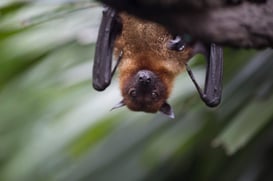 Bat hanging upside down from tree
Bat hanging upside down from tree
What are bats, and why are they protected?
Learning about bats and why they are legally protected within the United States is key to understanding why bat removal is a highly-litigated process.
Bats are mammals of the Chiroptera order and the only mammal capable of legitimate flight. This unique skill is due to their forearms that have been adapted as wings, allowing them to sustain true flight, unlike other “flying” mammals that actually glide. In fact, bats are more nimble than most birds while in flight, their thin connective membrane wings providing them added agility.
Bats within the United States are generally small, the most common of which being the size of a human thumb: the little brown bat. Another common bat is the aptly named big brown bat, which is about double the size of the small brown bat, though otherwise nearly identical. While most bats we encounter here in the U.S. are quite small in size, bats in other parts of the world can grow surprisingly large. The flying fox bat, native to the Philippines, is considered to be the largest bat in the world, with a wingspan of up to 5 feet!
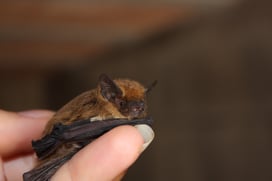 Little brown bat
Little brown bat
There are over 1,400 species of bats, making them the second largest order of mammals, preceded only by rodents. Bats are generally divided into two suborders: fruit-eating megabats and echolocating microbats. Despite these suborders, the vast majority of bats are insectivores, while the rest are either fruit-eaters or nectar-eaters. Most bats are nocturnal (though not all), and many roost in caves or other dark refuges (ahem… attics). Found throughout most of the world, bats live pretty much everywhere, with the exception of arctic regions that experience subzero temperatures.
Bats serve an incredibly important role in our ecosystem by pollinating flowers and dispersing seeds. In fact, many tropical plants rely entirely on bats for their pollination and continued dispersion. Bats can also be great forms of organic pesticides as insectivorous bats can protect crops by eating crop-destroying pests. They are particularly influential in limiting the mosquito population and, as a result, limiting the spread of mosquito-borne diseases. Bats can eat their own weight in mosquitoes in just one night!
The bat’s crucial role in our ecosystem is only part of the reason these creatures are legally protected on both state and federal levels. They are also protected due to their threatened and endangered species status. Due to various human activities, the bat population has steadily declined in years past. Destruction of the bat’s environment, such as deforestation and water pollution, has put the species at risk and left them vulnerable. Mining activities have also forced bats to leave their native environments, forcing them to seek shelter elsewhere. White-nose syndrome, a cold-loving fungus that affects hibernating bats, has also drastically impacted the bat population.
 Result of deforestation
Result of deforestation
Certain U.S. bat species are protected under the Federal Endangered Species Act of 1973 and the Fish and Wildlife Coordination Act of 1956. While different states have varying laws regarding how to handle a bat, most all agree that it is illegal to kill a bat, especially without express permission from the U.S. Fish and Wildlife Service. Violating such laws can result in severe penalties and fines.
How do bats get in my attic?
You may be wondering how bats get inside your attic in the first place. Like many pests, bats find their way into your home through small gaps or cracks in your home’s exterior. Due to their small stature, bats are able to slip through even the smallest of holes, even as small as 6 millimeters wide (about the size of a dime). Because many bats enter through the top levels of the home, it can be incredibly difficult to see potential entry points, especially from ground level. This makes preventing bats tricky without a detailed exterior inspection of your home from top to bottom.
Most homeowners expect that bats will roost in the rafters of their attic, and many do. However, bats will also take up residence in soffits, between interior walls, and even under insulation. Determining a bat’s exact location can be surprisingly difficult if they aren’t plainly obvious in your attic hanging from the rafters.
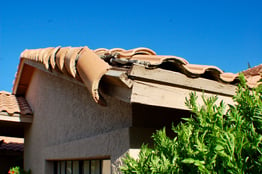 Damaged roofing and entry point for bats
Damaged roofing and entry point for bats
Can bats cause damage to my home?
While bats offer many benefits to humans when living in their native habitats, once they take up residence in your home, they cause much more harm than good. The presence of bats can actually cause structural damage to your home. Bat guano, or droppings, remains wet and heavy, rotting wood structures in your home and attic and causing the wood to decay. Worse, this can go on for years if you’re unaware of a bat’s presence, causing severe structural damage over time.
Bats may also damage your home’s insulation. While bats roost and search your attic for accommodations, their droppings will spread throughout your home’s insulation, damaging the insulation and spreading bacteria. Bat droppings are known to cause histoplasmosis when inhaled, resulting in a serious fungal respiratory illness that can be potentially life-threatening. Remediation of insulation damaged by bat droppings is imperative for your health and your home insulation's fortitude.
The presence of a large colony of bats may also result in a pungent ammonia-like smell due to their collective urine. This scent can be overpowering and difficult to live with, requiring full removal of affected materials. Likewise, bat urine and droppings can cause staining on your ceilings and walls as the waste seeps down from above. Due to bat waste carrying the potential of disease, it’s crucial to have impacted areas removed and remediated by a professional.
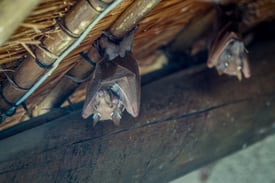 Bats roosting in rafters
Bats roosting in rafters
How do I know if I have a bat infestation?
It’s not uncommon for homeowners to go years without knowing they have bats residing in their attics or walls. Sometimes, a bat colony’s presence isn’t apparent until a full-on infestation has occurred. Needless to say, it is best to tackle a bat problem well before an infestation has occurred. Here are some signs to look out for that may indicate bats in your home:
- Piles of droppings near entry points, often in the attic.
- Droppings on attic insulation.
- A strong smell of ammonia in your home, especially in the attic.
- Stains on attic walls or even the ceilings below the attic.
- Seeing live or dead bats in your home.
- Hearing squeaking noises from within walls or the attic accompanied by scratching.
It’s important to know that bats are creatures of habit. Bats will likely return to the same spots year after year if no preventative measures are taken to stop their entry. In addition, bats have up to two pups each year. These pups will often remain stowed away in your attic or chimney.
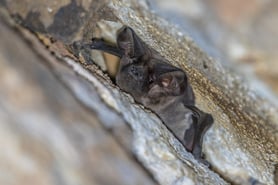 Young bat hiding in damaged chimney
Young bat hiding in damaged chimney
How do I remove bats from my attic if they’re protected?
Due to the bat’s protected status, removing them requires a great deal of knowledge and careful execution of the task. Bat removal is a job best left to professionals to prevent harm to not only you and your family but also the bats themselves. We highly encourage you to contact a pest control professional with experience removing bats safely and legally. DIY attempts to remove bats may result in harm to you or your family, death of the bats involved, and stiff penalties, including expensive fines to the individuals conducting improper removal.
EcoShield never kills bats in order to remove them. Our expert pest professionals use safe removal techniques that are informed by the bat’s natural lifecycle, regional seasonality, and proven tactics, such as one-way bat tubes so they can fly out but not reenter. Once the bats are out of the structure, our exclusion experts seal the entry points with a variety of permanent materials that prevent bats from getting back into the home.
Bat removal should not occur when pups are likely left behind in the roost (time period dependent on your region). In most areas, the best time to control bats is in late summer to early fall, when they are most likely to have left for the winter. Generally, sealing and prevention methods should be implemented in late fall and winter.
At EcoShield, we believe prevention is always the best first-line defense for all pests, including bats. There are no pesticides approved to control bats. Proper sealing of your home, identifying and remedying entry points, along with a thorough inspection is key to the prevention of bats. Due to the additional barriers and legalities involved in excluding bats, EcoShield recommends contacting a trusted professional to shore up and protect your home from bats entering it before they ever become an issue. Learn more about EcoShield’s preventative and active exclusion services here.
A bat infestation is one of the more difficult pest problems to tackle, with risks and legalities to consider before you begin. You’ll want to know what type of bats are in your home and carefully avoid harming these creatures. If you need to remove bats from your property, you can count on EcoShield Pest Solutions to get the job done.
We provide:
- Safe, effective, and humane bat removal
- Exclusion services, so they don't come back
- Fast and reliable service
- Licensed and insured technicians
Please call or fill out the form on this page to get expert help.